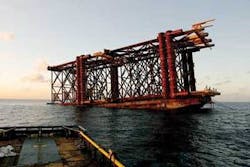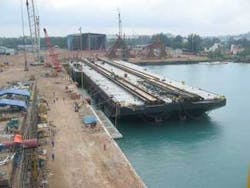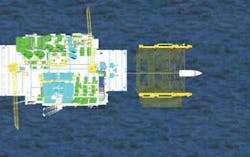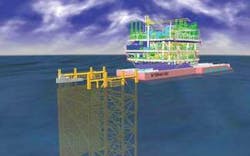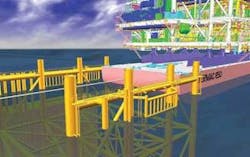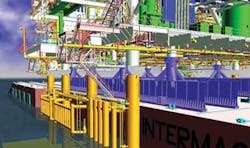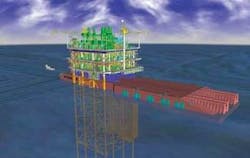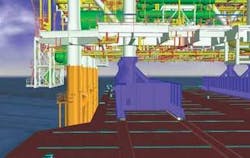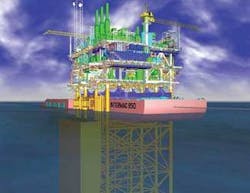Intermac 650: Changing form for changing times
Barge launches largest jacket ever built in China
Alp Kocaman, Richard Newhouse, Lee Taylor, Juan Seto, Ray Scippa - J. Ray McDermott, S.A.
J. Ray McDermott’s Intermac 650 (I-650) was built in 1982 to address the growing need for transporting and launching jackets in ever increasing water depths. It was the largest launch barge in the world for five years (1982-1987) and retains the number two spot today. Its initial design was for the transport and launch of fixed jackets in the Gulf of Mexico weighing up to 40,000 tons.
The I-650 launched numerous deepwater jackets and compliant towers during the first decade of its existence, including Union Oil Cerveza and Cerveza Ligera, BP Mississippi Canyon block 109, Shell Boxer, Texaco Petronius, and Hess Baldpate. These structures weighed from 12,000 to 28,000 tons. In the 1990s, as oil and gas production entered increasingly deeper water depths and the need for fixed jackets gave way to floating production units (floaters), the I-650 was charged with the new task of transporting and installing massive topsides for floaters, such as the Shell Auger TLP weighing 23,000 tons.
Due to a steady increase of oil and gas production in other parts of the world, the I-650 was pressed into global service. In the Asia-Pacific region, for example, the barge transported and launched two jackets for the Bayu Undan Gas Recycle Project during May - July 2002. The I-650 transported together and then launched individually the DPP (10,982 tons) and then CUQ (10,653 tons) jackets.
The complexity of modern deck design has increased overall deck weight and also made single piece fabrication practically mandatory. With derrick barge crane lifting capacities limited, barges like the I-650, with its capacity to transport and install heavy decks, have become essential resources for the future of offshore installation.
Arthit platform
At the end of 2004, J. Ray received a bid inquiry from PTT Exploration and Production Company Ltd. (PTTEP) for the Arthit APP Central Facilities Platform in the Gulf of Thailand. The scope included fabrication, loadout, seafastening, transportation, installation, hookup, and pre-commissioning of what grew to be a 19,842-ton topside. J. Ray was awarded the Arthit contract in May 2005.
The company’s involvement in the Arthit platform project began after the detailed design of the jacket and the deck had been completed. The jacket leg spacing and slot width were configured to accommodate vessels with a 138-ft beam. Schedule constraints were such that the deck and the jacket designs could not be modified to suit the I-650. The original beam of 170 ft was too wide for the design and the barge could not be used for a floatover, which involves the positioning of a deck over the jacket legs with the transport barge coming between the jacket legs and then ballasting the barge until the deck is attached to the legs. The barge needed to change.
Key decisions
J. Ray engineers initially suggested narrowing the aft section of the barge to 138 ft to accommodate the existing deck design, by floating over the jacket. It was necessary to maintain the basic launch capacity of the barge, as it remains the primary launch vessel for heavy jackets within J. Ray’s fleet. Additional barge modifications included a rapid ballast system to accomplish ballasting the barge quickly, thus transferring the deck over to the jacket in a short time span. Another modification involved barge longitudinal bulkhead strengthening. In order to distribute the topside’s leg loads into the I-650 structure, a Deck Support Frame (DSF) were designed, with four longitudinal girders aligned with the barge longitudinal bulkheads. The DSF was designed so that it can be modified for topsides with various leg spacings. As a result of being designed and built as a strong launch barge, I-650 longitudinal bulkhead load capacity was lower toward the bow. To support the topsides near the bow, certain portions of the four longitudinal bulkheads at 33 and 57 ft off-center on both port and starboard sides needed to be strengthened.
The last modification requirement was the addition of wedges at the barge stern. Due to the rake at the bow, there was inadequate cross-section to load out over the bow. As a result, topside loadouts were launched over the stern, and then the structure would be pulled all the way to the bow. The I-650 stern has a ramp where the launch rocker arms are normally located. This location is 92.5 ft long and the ramp slopes to 28 ft below the barge deck. To support the deck during loadout, four infill pieces in the shape of a wedge were inserted.
JRM Marine Operations and Equipment & Machinery management made the following key decisions concerning the I-650 modifications:
- The I-650 would have to remain capable of launching a nominal 27,558-ton jacket. This precludes narrowing over its full length
- The narrowing would take place at the forward portion of the I-650
- All four longitudinal bulkheads supporting the DSF would be strengthened to a consistent nominal capacity, to provide flexibility for possible future floatover projects
- All modifications requiring dry docking had to be accomplished during the scheduled November 2005 to January 2006 dry docking
- “Light Ship Weight” includes launch-ways, launching jacks, secondary and primary rocker arms, and stern wedges, but not the DSF skid plates or deck loadout wedges. Appropriate calculations must be made for flotation and stability studies during deck transportation cases.
Both J. Ray management and the client found the engineering proposal acceptable. The plan, however, was complicated by commitments made by J. Ray for the barge prior to the Arthit project as well as drydock availability for modifications. The proposed changes had to be implemented by February 2006, which meant all engineering needed to be completed and approved by the American Bureau of Shipping (ABS) by December 2005.
Modifications under duress
Working closely with the Arthit PMT offshore installation manager, J. Ray’s Houston engineering office started work on the Arthit floatover engineering and the design of the DSF, while its New Orleans engineering office tackled the details of the I-650 modifications. While one team was busy figuring out what needed to be done, the other team was completing detail designs and getting ABS approvals. In the middle of all this, Hurricane Katrina struck New Orleans, where part of J. Ray’s engineering team and ABS were located, practically stopping all barge detail design work. The J. Ray engineering team had to be relocated to Houston, as did ABS. As these teams regrouped, Hurricane Rita’s impending threat to Houston caused additional delays. The teams overcame these obstacles and still delivered ABS approved drawings and documents to the Keppel FELs shipyard on time.
The barge was drydocked at Keppel FELS Tuas shipyard in Singapore on Nov. 13, 2005, as planned, and left the shipyard on Feb. 19, 2006, one week later than planned. Drydock modification was carried out at the Raffles Dock (1,099 ft x 197 ft), which is capable of handling 330,000 dwt. The total amount of new steel added to the barge was 1,157 tons, with 2,111 tons of steel removed. The bow half of the barge was narrowed to 138 ft; pumping, piping and electronic monitoring upgrades were accomplished; and 16 valves of 24-in. diameter were added to the bottom of eight major ballast tanks (two valves per tank) that can be controlled from a central point. By selecting a combination of valves, the barge can be ballasted quickly, transferring the deck weight over to the jacket and limiting the exposure of the deck to the environment. The rapid ballast system is digitally controlled and includes a digital tank gauging system and digital draft gauging system.
Launch
Immediately following departure from the Keppel FELS shipyard, the I-650’s first job was to launch a jacket under contract to Offshore Oil Engineering Co. Ltd. in the Panyu 30-1 natural gas field in the South China Sea. At 699 ft tall and 25,200 tons, it was the largest jacket ever designed and constructed in China and represented a significant step in the development of China’s engineering of deepwater offshore oil technologies. The project also provided a real-life towing test of the reconfigured barge, from Singapore/Batam to China. This launch occurred in April 2006.
The I-650 is now preparing to launch the Arthit jacket and then will perform the 18,000-ton Arthit deck loadout and floatover. Later this year, a test of the ballast system will be conducted at J. Ray’s marine base on Batam Island, Indonesia, to prove the gravity feed ballast system’s flow rate capacity. Calculations indicate that the ballasting capacity using the valves will be superior to ballasting by pumps. Estimated barge draft change exceeds 13 ft per hour. Another set of tests will be conducted at Offshore Model Basin in Escondido, California, in September 2006 to prove the effectiveness of the floatover characteristics of the barge, as well as towing characteristics. Analyses performed to date indicate that the barge has maintained the launch capacity of a minimum 25,000-ton jacket and the capacity to float over decks of at least 20,000 tons at the bow.
J. Ray recently announced a contract by Cuu Long Joint Operating Co. to provide engineering, procurement, construction, installation, hook-up and commissioning services for a central processing and production platform with an integrated 16,400 ton deck, and associated infield pipelines for the Su Tu Vang field, offshore Vietnam. The platform, to be installed in about 170 ft of water, includes the 16,400 ton deck; a 4,340 ton, eight-leg jacket; piles weighing in excess of 4,100 tons; and associated pipelines. The I-650 is scheduled to perform the jacket installation as well as the deck floatover.
null
null
null
null
null
null
null
